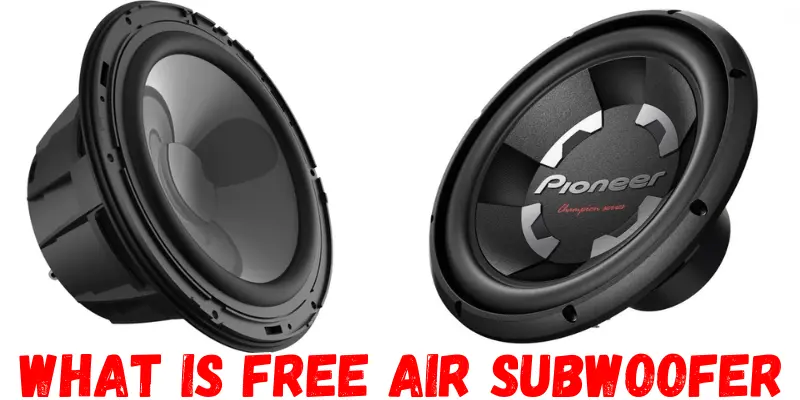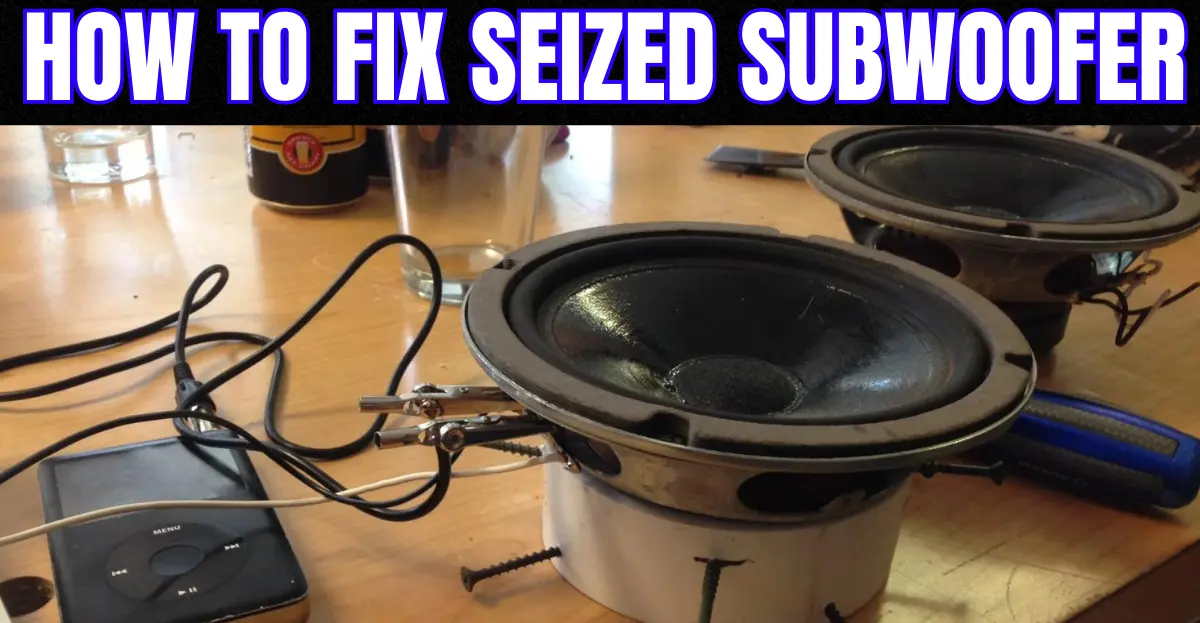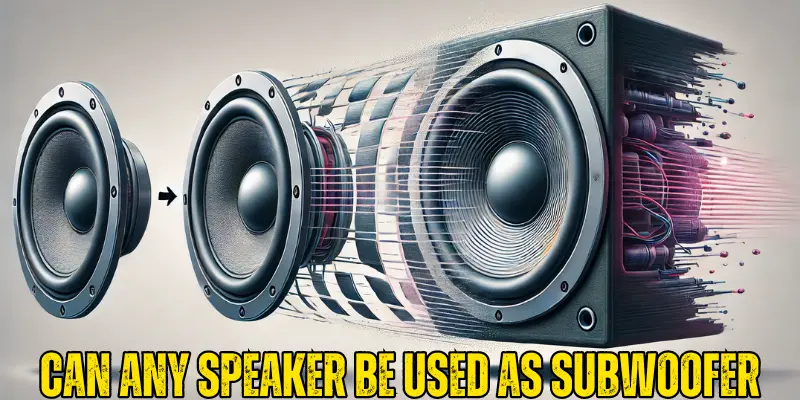
Have you ever wondered about the magic behind the deep, resonating bass in your favorite songs? Subwoofers play a crucial role in our audio systems, delivering those powerful low frequencies that make music come alive.
Today, I want to introduce you to a unique kind of subwoofer—the free-air subwoofer. Unlike traditional subwoofers enclosed in boxes, a free-air subwoofer operates in an open space, offering a distinct approach to sound reproduction.
Let’s dive into what makes a free-air subwoofer different, its design, and why it might just be the perfect addition to your sound system.
What is Free Air Subwoofer?

Have you ever wondered about the magic behind the deep, rich bass in your favorite songs or movies? Let’s dive into the world of free air subwoofers, a unique player in the audio system family, and uncover what sets them apart from their traditional counterparts.
Definition of a Free Air Subwoofer
A free air subwoofer is a type of speaker designed to use the air inside your car trunk, room, or any existing open space as its enclosure.
Unlike regular subwoofers that require a boxed enclosure to produce sound, free-air subwoofers operate without one. This design allows them to blend seamlessly into your audio setup, providing deep bass without the need for bulky boxes.
How Free Air Subwoofers Differ from Traditional Subwoofers
The main difference between free air subwoofers and traditional ones lies in their design and installation requirements. Traditional subwoofers need a specific type of enclosure to function correctly, which can take up a significant amount of space.
Free air subwoofers, on the other hand, are more flexible in terms of placement. They can be mounted on a board, placed against the rear deck of a car, or integrated into furniture, saving space while still delivering quality sound.
The Working Principle of Free Air Subwoofers
Free air subwoofers rely on the open air behind them to serve as a virtual enclosure, using the environment to enhance sound production. This setup requires precise installation and tuning to ensure the subwoofer performs well.
The lack of a physical enclosure means that free air subwoofers must be specifically designed to handle the extra load and provide clear, distortion-free bass. By efficiently moving air in the open space, they create deep and resonant bass tones that can rival enclosed subwoofers.
Free air subwoofers offer an innovative solution for adding bass to your audio system without sacrificing space. They’re perfect for those looking to enhance their sound experience while maintaining a minimalist setup.
Whether you’re a car audio enthusiast or just looking to upgrade your home theater system, understanding the unique attributes of free air subwoofers can help you make an informed decision.
Key Features of Free Air Sub

When we talk about upgrading our audio systems, whether it’s in our cars or homes, the goal is always to achieve that perfect balance of quality, power, and space efficiency.
Enter the free air subwoofer, a game-changer in the world of sound. Let’s break down the key features that make free air subwoofers stand out, and why you might consider one for your setup.
Design Characteristics of Free Air Sub
Free air subwoofers are designed with flexibility and efficiency in mind. Unlike traditional subwoofers that require enclosures, these ingenious devices can operate in open spaces. They typically have a more robust and durable construction to compensate for the lack of a protective box.
This design allows for easier integration into various settings, such as vehicle trunks or custom spots in your home, without the need for bulky, space-consuming enclosures.
Technical Specifications Commonly Associated with Free Air Sub
When delving into the technicalities, free-air subwoofers often feature a higher sensitivity rating and a more extensive power handling capacity.
The sensitivity rating is crucial because it determines how effectively the subwoofer converts power into sound. A higher sensitivity means less power is needed to produce high-quality sound.
Additionally, their power handling capacity ensures they can manage the energy from your amplifier without distortion, allowing for a clearer, richer bass response.
Benefits of Using a Free Air Subwoofer in Your Audio System
The advantages of incorporating a free air subwoofer into your audio system are numerous. Firstly, the space-saving aspect cannot be overstated. By eliminating the need for a bulky enclosure, you gain more room while still enjoying deep, immersive bass.
Moreover, the installation flexibility opens up creative possibilities for audio setups that were previously constrained by the need for specific types of enclosures.
The sound quality produced by free-air subwoofers is another significant benefit. They’re engineered to deliver a clean, precise bass response that enhances the overall listening experience.
Whether you’re watching a movie with earth-shattering effects or losing yourself in bass-heavy music, a free-air subwoofer can provide an immersive audio experience that traditional subwoofers struggle to match in space-limited scenarios.
Installation and Placement of Free Air Subwoofer

When it comes to enhancing your audio system with a free-air subwoofer, knowing the ins and outs of installation and placement can make all the difference.
Let’s walk through the process, share some best practices, and tackle common challenges so you can enjoy the deep, resonant bass that your music deserves.
Overview of the Installation Process for Free Air Subwoofers
Installing a free air subwoofer might seem daunting, but it’s quite straightforward with the right approach. The first step is to choose the location. Since free air subwoofers don’t require enclosures, you have more flexibility.
Common spots include the rear deck of a vehicle or a panel in your home theater setup. The key is ensuring the space behind the subwoofer is open to the area you want to fill with sound.
Next, you’ll need to securely mount the subwoofer. This often involves creating or utilizing an existing cutout in the mounting surface. Ensuring the subwoofer is tightly sealed around the edges is crucial to prevent air leaks, which can diminish sound quality.
Best Practices for Placement Within a Vehicle or Home Audio Setup
Placement is crucial for maximizing the performance of your free-air subwoofer. In vehicles, mounting it on the rear deck can leverage the trunk space as a natural enclosure, enhancing the bass response.
For home audio systems, consider areas where the subwoofer can use open space effectively, such as near corner walls or furniture that can help reflect and amplify sound.
Positioning the subwoofer where it can ‘breathe’ properly without obstruction is also vital. Make sure there’s enough space around the subwoofer for air to move freely, as this directly impacts sound quality.
Common Challenges and Tips for Overcoming Them
One of the common challenges is finding the optimal spot for your subwoofer where it delivers the best sound without causing vibrations or rattles. To combat this, use sound-dampening materials around the mounting area to minimize unwanted noise and ensure a clean bass output.
Another challenge is ensuring the subwoofer is correctly wired to your audio system. Pay careful attention to the polarity of the connections and the power requirements of the subwoofer to avoid any damage or suboptimal performance.
Lastly, tuning your subwoofer to blend seamlessly with the rest of your audio system can be tricky. Start with a lower volume and gradually increase it to find the right balance. Using an equalizer can also help adjust the bass levels to your preference.
Installing and optimally placing a free-air subwoofer can significantly enhance your audio experience, whether you’re cruising in your car or enjoying a movie night at home.
By following these guidelines and tackling challenges head-on, you’ll be well on your way to achieving the perfect bass setup that complements your audio system beautifully.
Performance and Sound Quality of Free-Air Subwoofer

When we talk about elevating our audio experiences, the performance and sound quality of our equipment play pivotal roles. Free air subwoofers, with their unique design and functionality, offer a distinctive approach to bass enhancement.
Let’s explore how these subwoofers impact sound quality, compare them to other types, and identify their ideal use cases and environments.
Impact on Sound Quality
Free-air subwoofers are known for their ability to deliver deep, resonant bass directly into your space without the confinement of an enclosure.
This open design allows for a more natural spread of sound waves, resulting in a bass that feels integrated into the overall audio experience rather than isolated or overpowering.
The key is their efficiency in moving air freely, which produces a clear and precise bass response. For listeners, this means experiencing every beat and bassline with clarity and depth, enhancing the overall richness of the music or audio content.
Comparing Performance to Other Types of Subwoofers
When compared to traditional enclosed subwoofers, free air subwoofers offer a different kind of value. Enclosed subwoofers might deliver a more concentrated and powerful bass punch, ideal for certain music genres or audio experiences.
However, free-air subwoofers excel in providing a balanced and widespread bass presence, making them perfect for creating a well-rounded sound environment.
The choice between the two often comes down to personal preference, the specific demands of the audio content, and the physical constraints of the listening environment.
Ideal Use-Cases and Environments
Free air subwoofers shine in scenarios where space is at a premium or when a seamless integration into the existing environment is desired. In vehicles, for instance, they utilize the trunk space to enhance the bass without sacrificing valuable storage.
In-home audio setups can be mounted on walls or furniture, offering a high-quality bass experience without the visual intrusion of a boxy enclosure.
These subwoofers are particularly suited to environments where a balanced audio landscape is preferred over isolated bass intensity. They’re ideal for audiophiles who appreciate depth and clarity in their music, home theater enthusiasts seeking an immersive audio experience, and vehicle owners looking to upgrade their sound system without compromising on space.
Pros and Cons of Free-Air Subwoofer

Choosing the right subwoofer for your audio system is a big decision, and free air subwoofers are an interesting option to consider. They come with their own set of advantages and limitations. Let’s dive into the pros and cons of free air subwoofers to help you decide if they’re the right fit for you.
Pros of a Free Air Subwoofer
Cons of a Free Air Subwoofer
Choosing the Right Free Air Subwoofer

Selecting the perfect free air subwoofer for your audio system is like finding the final puzzle piece that makes the picture complete. It’s not just about the bass; it’s about enhancing your overall listening experience.
Let’s dive into what you need to consider, some brands and models that have caught your eye, and how to test your pick to ensure it hits the right notes.
Factors to Consider
Compatibility:
First up, make sure the subwoofer matches your system’s power and impedance requirements. It’s like pairing a good wine with dinner; the right match can elevate the experience.
Sensitivity:
Look for a subwoofer with high sensitivity. This means it can produce louder sound with less power, making it both efficient and powerful.
Size and Space:
Consider the space you have available. While free air subwoofers are more flexible regarding installation, you still need to ensure it fits where you intend to place it.
Sound Quality:
Decide on what type of bass you’re after. Some subwoofers are better for deep, booming bass, while others excel at a tight and precise sound. Think about your favorite tunes and what will do them justice.
Recommended Brands and Models
While I can’t play favorites, I can point you toward some brands that consistently get rave reviews from audiophiles and casual listeners alike:
Remember, the best choice varies depending on your specific needs and preferences. It’s always a good idea to research and compare models within these brands.
Tips for Testing and Evaluating a Free Air Subwoofer Before Purchase
Choosing the right free-air subwoofer involves a bit of homework and a lot of listening, but the payoff is worth it. The right subwoofer can transform your audio experience, filling your space with rich, detailed bass that brings your favorite music and movies to life. Take your time, do your research, and soon you’ll be enjoying the deep, immersive sound you’ve been dreaming of.
Conclusion on What is Free Air Subwoofer
In our journey to understand What is Free Air Subwoofer, we’ve explored its unique design, performance, and the benefits it brings to any audio system.
Free air subwoofers stand out for their ability to deliver deep, resonant bass without the need for bulky enclosures, offering a space-saving solution that doesn’t compromise on sound quality.
The versatility and efficiency of free-air subwoofers make them an excellent choice for those looking to enhance their audio experience in a vehicle or home setup.
Their installation flexibility, combined with the ability to produce high-quality sound, allows for creative audio solutions that cater to personal preferences and spatial constraints.
Finally, choosing the right free-air subwoofer involves considering factors such as compatibility, sensitivity, and the desired sound quality. By taking these into account, you can select a subwoofer that not only meets your needs but also elevates your listening experience.
Whether you’re an audiophile or just someone who appreciates good sound, incorporating a free-air subwoofer into your audio system is a decision that can significantly enhance your enjoyment of music and movies alike.
FAQs: What is Free Air Subwoofer
Can you put a free-air sub in an enclosure?
Yes, you can put a free-air sub in an enclosure, but it defeats the purpose of its design. Free air subs are optimized for use without an enclosure, using the surrounding air space as their box.
Why does a subwoofer need air?
A subwoofer needs air to move freely around its cone. This movement creates sound waves. The air acts as a medium for these sound waves, allowing the subwoofer to produce bass.
How do you break in a subwoofer free air?
To break in a free air subwoofer, play music through it at a moderate volume for several hours. This allows the subwoofer’s components, especially the suspension, to loosen up and perform optimally.
Why is my subwoofer so weak?
A weak subwoofer could be due to several reasons: improper setup, insufficient power, incorrect tuning, or it’s not the right match for your system’s overall capabilities.
Can any subwoofer be free to air?
Not all subwoofers are designed to be used as free air. Free-air subwoofers are specifically built to operate without an enclosure, so using a regular subwoofer in this way may result in poor sound quality or damage.
How does a free-air subwoofer work?
A free-air subwoofer works by using the open air behind it to create a bass response. It doesn’t require an enclosure and relies on the volume of air in the vehicle or room to serve as its box.
Are free air subs any good?
Free air subs can be very good, especially in situations where space is limited. They provide a solution for adding bass without the bulk of an enclosure, making them ideal for certain setups and preferences.






